CITY OF AREQUIPA
The city of Arequipa is the capital of the department of the same name, Arequipa is also well-known like the "White City", this is one of but the beautiful cities of Peru.
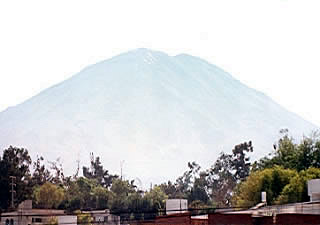
The "White City" rises to the feet of Misti volcano.
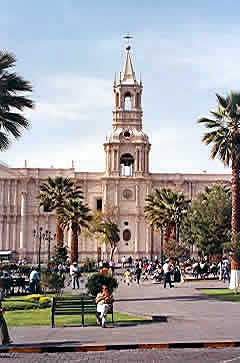
Partial Vista of the Cathedral
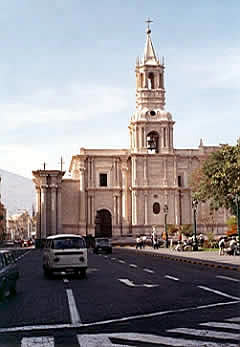
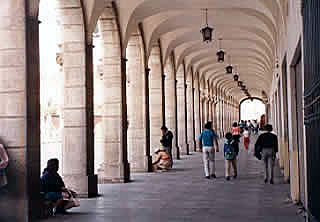
The seat of arms of Arequipa characterizes by his arquerias at two levels.
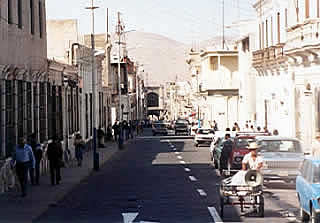
Sillar is the preponderantly dominant element in the contrucciones arequipeñas, this element is the one that has given name him of white city.
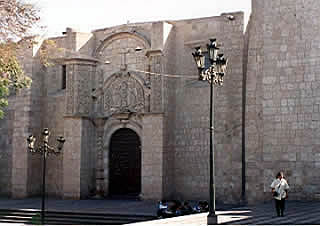
Misti volcano is slept, but Arequipa awakes each morning in constant boiling. And although in their top small smoke clouds are seen regularly, not for that reason the arequipeños - proud as few of their earth let invite the tourist to cross their white streets and their traditional seats. The satately city of Arequipa must to the characteristic color of its houses and other constructions to the stone of sillar, of volcanic origin, with which they are done.
Founded like Beautiful Villa of Our Mrs. of Asunta, the hierarchy of city in 1541 was granted to him. Arequipa has been in addition, throughout its history, cradles of preclear men of the policy and the Peruvian culture. Today, the visitor finds in his spectacular neon-Renaissance Cathedral, the impressive monastery of Santa Catherine and in its large houses and museums, reasons than more sufficient to visit.
Main Attractive:
Seat of Arms of the city of Arequipa
Surrounded by the Church Cathedral and diverse vestibules, the Seat of Arms presents/displays a beautiful bronze source of three plates crowned with the figure of a soldier of century XVI. To this personage the "Tuturutu" is called to him, that according to history was the one in charge to warn of any novel event. Around the seat three vestibules done with granite and vaults of brick and lime can be appreciated: the Vestibule of the Town hall (Vestibule of the Municipality), the Vestibule of the Delights (Vestibule of San Agustín) and the Vestibule of Rejoicing (Vestibule of Flowers).
Cathedral of the city of Arequipa
Seat of Arms. Tel: (054) 23-2635/40-5393. Visits: L-S 7:00-11:30 and 17:00-19:30; D 7:00- 13:00 and 17:00-19:00. It is considered like one of first religious monuments of century XVII in the city. It was constructed in sillar (stone of volcanic origin), with brick vaults; it was destroyed by a reconstructed fire in 1844 and in 1868 by the architect arequipeño Lucas Poblete. It is of neoclassic style and the income to the temple are located in the lateral ships. Hard it was struck by the earthquake of year 2001, the one that affected its towers seriously.
Church and Complex of the Company
Intersection of the streets General Mora'n and Alvarez Thomas, Seat of Arms of the city of Arequipa. Visits: L-D 09:00 - 11:00 and 15:00 - 18:00 East set is integrated by diverse buildings raised by the jesuitas as much for religious aims as for house, and forms a representative monument of the own religious architecture of century XVII (1660). In the middle of the set it excels the temple. The Church of the Company was designed in 1573 by Gaspar Báez and was destroyed by an earthquake in 1584. The present structure data of 1650. Cusqueña has approximately 66 linen cloths of the school, artists like Bernardine Bitti and Diego of the Bridge.
Complex and Church of San Francisco
Zela street cdra. 1 s/n. Tel: (054) 22-3048. Church: Visits: L-S 7:00-9:00 and 17:00-20:00; D 7:00-12:00 and 17:00-20:00. Convent: Visits L-S 9:00-12:30 and 15:00-17:00.
The complex includes/understands the franciscana church, the convent and a temple smaller well-known as of the Third Order In the church they emphasize the baroque púlpito decorated with shortened relief and the frontal of silver of the greater altar. In addition, a short passage denominated the Manguillo of San Francisco has been integrated to the set, that separated the church of which it was the first School of Educandas and later the jail of women; today it has been turned a commercial center of crafts and is known as "I found the Iron".
Monastery of Santa Catherine
Street Santa Catherine 301. Visits: L-D 9:00-16:00.
Constructed to lodge more to the daughters of the distinguished families of the city with religious vocation, the monastery was inaugurated the 2 of October of 1580, under the invocation of Santa Catherine de Siena, like a center of absolute closing, and thus it stayed until the 15 of August of 1970.
It occupies an approximated area of 20 thousand square meters and its distribution is similar to the one of the first districts of Arequipa. It presents/displays very diverse rooms architectonic. One of atmospheres has been prepared like pinacoteca to exhibit linen cloths of the schools cusqueña, Quito and influences arequipeña. Account in addition with other rooms or sectors to visit like the Claustro of the Portería, the Pre-Columbian Museum, the Claustro of San Francisco, etc.
Convent of the Recoleta
Jr Recoleta 117. Tel: (054) 27-0966. Visits: L-S 9:00-12:00 and 15:00-17:00.
Email: convent-the-recoleta@terra.com.pe
Franciscano convent founded on 1648, was opened to the public just in 1978. It presents/displays different styles that go from the Romanesque one to the neogothic one, due to his diverse reconstructions (the last data of 1940). Account with four claustros and eleven atmospheres, in addition to two rooms of pre-Columbian art, two rooms dedicated to amazonía and a room of religious art. It has, also, a pinacoteca with linen cloths of the school cusqueña and arequipeña and a valuable library that blanket more than 20 thousand volumes and incunables.
Church and Convent of Santo Domingo
Intersection of the streets Santo Domingo and Rivero. Tel. (054) 21-3511.
Visits: L-S 7:00-12:00 and 15:00-19:30; D 5:45-13:00 and 18:30-19:45.
Architectonic, they characterize to this church the tower of the bell tower, its vestibule with esquinado pedestal and its impeccable arc underneath the choir. In the interior pieces of imaginería and linen cloths with sacred reasons can be appreciated. Similarly, its lateral cover being oldest of Arequipa is well-known. Claustro greater of the convent was constructed around 1734.
House of the Moral
Moral Street 318, Surrounded. Visits: L-S 9:00-17:00 and holidays 9:00-13:00.
Large house of century XVIII, constitutes one of older and important architectonic monuments of the baroque one in Arequipa. The house must its name to an old tree of Moors that grows in its main patio. It has furniture of the colonial and republican time. The cover in sillar constitutes an art work in which carved figures are appraised carefully. For example, a crown on a shield is maintained by two angels, as well, the shield is made up of a castle, a bird, puma and two crossed keys. Also it emphasizes a hall with "ancient" maps of America of century XVI.
District of San Lazaro
To 5 blocks of the Seat of Arms of the city of Arequipa.
This district of side streets, close passages, small seats and ample houses is the most representative zone of old Arequipa. In this place the Dominican priests in 1538 settled down themselves, constructing a hermitage for the evangelización of the native ones of this place and to prepare the land to found a new Spanish city. He emphasizes a small bridge that unites the today Church of San Lazaro and his square with the rest of the district.
Goyeneche House
Street Favor 201. Tel: (054) 21-2251. Visits: L-V 9:15-15:00.
Large house of sillar of half-full of century XVI, completely decorated respecting the colonial style. Linen cloths of the school are conserved cusqueña and sculptures of the granadina school of century XVII. It must his name to Don Juan de Goyeneche and Aguerreverre, who acquired it in 1782. At the moment it is the seat of the Central bank of Reserve in Arequipa.
Church San Agustín
Intersection of the streets San Agustín and Bolivar. Tel: (054) 22-0066. Visits: L-S 8:00-12:00 and 17:00-19:00; D 8:00-13:00 and 17:00-19:00.
Constructed in 1575, it presents/displays a facade that dates from first half of century XVIII and is considered one of the best ones of its time. Architectonic it belongs to the baroque mestizo with predominance of sillar in its construction. In the interior of the temple they emphasize the cupola, the neoclassic altars and specially the greater altar, by its careful carving and its applications in gold bread.
Church The Favor
Intersection of the streets Merced and Tristán. Tel: (054) 21-3233.
Visits: L-V 8:00-13:00 and 16:00-19:00 and S 8:00 - 12:00.
Its construction began in 1551 and it concluded in 1607. It has an attractive lateral cover in which it emphasizes the image of the Virgin of the Mercedes accompanied by two mercedarios saints. In their interior important works of art like the "Appearance of the Virgin to San Pedro Nolasco" are conserved, in sacristía, and a series of referring pictures to the Virgin of the Favor, in the room to capitulate. As much the church as the convent, the second constructed in the city, has been built using to sillar arequipeño. Claustro conserves a library that dates from the virreinal time.
Tristán house of the Well
Street San Francisco 108. Tel: (054) 21-2209.
Visits: L-V 9:15-12:45 and 16:00-18:00 and S 9:30-12:30.
Traditional colonial large house whose facade exhibits carving of racially mixed baroque style; besides to have ample and characteristic inner patios. It was constructed in 1738 for general Domingo Tristán of the Well. At the moment it is property of the Continental Bank.
Archaeological museum of the University of San Agustín
Intersection of the streets Alvarez Thomas and Old Palace. Tel: (054) 28-8881.
Visits: L-V 8:15-16:15.
It exhibits a varied collection that include/understand líticos objects, bony rest of human, ceramios sacrifices of the cultures Nasca, Tiahuanaco, Huari and Inca, and gold objects and silver of the times colonial Inca and.
Museum of Archaeology of the Catholic University of Santa Maria of Arequipa
Street Green Cross 303. Tel: (054) 95-9636. Visits: L-V 9:00-12:00 and 14:00-17:00
The museum exposes around 1000 objects (ceramic, textile, fardos undertakers, líticos objects, of wood and metal) of the different developed cultural groups in the department, from 12,000 year a.C. to the colony: Nasca, Tiahuanaco, Wari, Churajón, Acarí, Aruni and Inca, in addition to transicional and colonial material.
Museum Andean Sanctuaries of the Catholic University of Santa Maria
Street Favor 110, Surrounded. Tel: (054) 21-5013. Visits: L-S 9:00-18:00; D 9:00-15:00.
* Momia Juanita will not be in exhibition because it will enter a period of conservacón until April ends of 2006.
It exhibits Lady de Ampato, momia Inca of a girl of 12 or 14 years, found in the top of Ampato volcano by the andinista Miguel Zárate, the archaeologist Jose Chávez and anthropologist Johan Reinhard, the 8 of September of 1995. According to the specialists, it is very probable that the girl whose rest were found congealed has died of a blow in sien it with a macana of granite of five ends. Apparently it would have been an offering to the Apu Ampato and its antiquity goes back to about 500 years.
Urbanization Glad Forest
Considered "the garden of the city" by its ample parks and immense trees that harmonize with the modern houses of the zone. In Glad Forest a monument in honor to Juan has been elevated Pablo Vizcardo and Guzmán, precursor of independence. It also emphasizes the Mill of Santa Catherine, completely recovered, located in the levee of the referred urbanization.
Viewpoint of Yanahuara
To 2 km of downtown of Arequipa (8 minutes in car).
It was constructed in century XIX and is conformed by a series of arcs of sillar in which the words of illustrious arequipeños have been recorded. The place has a privileged Vista of the city and Misti volcano.
Town of Sabandía
To 8 km to the south of the city of Arequipa (20 minutes in car).
Ample andenerías and three volcanos, the Misti, the Chachani and the Pichu Pichu, give frame to the landscape that surrounds this traditional town. Some of the houses still conserve characteristics of the virreinal pattern or the republican of century XIX. A complex of recreation with two swimming pools has been constructed that take advantage of waters you cold of the springs that surround the zone.
Mill of Sabandía
Located in the town of Sabandía.
Constructed in 1785, it represents the typical architecture of the region, in which the use of sillar predominated. Their solid abutments and peasants are characteristic balconies. Also, the used techniques can be appreciated to process the wheat using the stone mills.
Mansion of the Founder
To 9 km of the city of Arequipa (15 minutes in car).
Constructed in sillar a cliff on the brink of madness, she is one of the large houses or more important and traditional mansions of the region. According to they count, Garcí Manuel de Carbajal, founder of Arequipa, sent it to construct for his son. Later, in 1785, Don Juan Crisóstomo de Goyeneche and Aguerreverre was its proprietor and remodeló giving the satately characteristics him that today are appraised. The main entrance is made up of a vestibule of vaulted ceiling, followed by an ample main patio on which to the windows and doors of the rooms are opened.
District of Cayma
To 3 km to the south of the city of Arequipa (8 minutes in car).
The town of Cayma is known like the "Balcony of Arequipa" by its privileged location that allows to descry all the city. Its central seat lodges the temple of San Miguel Arcángel, constructed in 1730 and considered an architectonic jewel by its racially mixed facade. In the annexed cural house the "Dining room of Bolivar" is conserved where, according to the Liberator counts itself, had lunch during his estadía in the town.
Misti Volcano
At 20 km to the northeast of the city of Arequipa, it is arrived until the skirts of the volcano (1 hour in light truck 4x4).
The Misti, with its 5825 msnm, is the image tutelary of the city. From the stop of his summit it is possible to descry the city of Arequipa, the valley of the Chili river and volcanos Chachani and Pichu Pichu.
Thermal baths of Yura
To 27 km to the north of the city of Arequipa (45 minutes in bus).
Pozas thermal located in the skirts of Chachani volcano, to 2575 msnm. They are known by the therapeutic properties of its waters, whose temperature fluctuates between 23° and 28°C. Between years 1810 and 1831, Don Jose Nogal and Noguerol constructed pozas that stay until the present time.
Caves of Sumbay - rock Art
To 97 km to the north of the city of Arequipa by the highway to Caylloma (1 hour 45 minutes in bus).
Located within the limits of White the National of Salt mines and Watered down Reserve, they lodge more than 500 figures of rock art. These representations, done possibly by the first settlers of the zone, approximately have an antiquity of 6000 to 8000 years.
Made snow-white Chachani
To 55 km to the north of the city of Arequipa (2 hours in light truck 4 xs 4). It is arrived until the camping bases and from this point a long walk of 6 hours approx begins to lacumbre.
Considered one of mountains of more difficult ascent in Peru, this snowing reaches more than 6075 msnm. It is also an inactive volcano but lava is still visible and presents/displays small precipices and moraines. In order to ascend two days and one night are needed.
District of Yarabamba
To 21 km to the south of the city of Arequipa (35 minutes in car).
The name of the district comes from two voices quechuas: "yaro" or "yara", an own shrub of the zone, and "bamba", that "Pampas" mean. In the town it is possible to be visited the mansion of Sands and Pinto and the colonial house of the Creek and Echevarría.
District of Quequeña
To 25 km to the Southeastern of the city of Arequipa (40 minutes in car).
This zone has been inhabited by lupacas, aymaras, quechuas, collaguas, puquinas and, in the middle of century XV, by the Incas. The name of this town would come from the puquina voice "quequeña", that means "rocky and solid place".
The main sites of interest are the Tree-lined avenue of the Willows, the Tree-lined avenue of Deads and the Gorge of Guanaqueros; it counts in addition on a church just recovered.
District of Chiguata
To 30 km to the east of the city of Arequipa (45 minutes in car), in the skirts of Pichu-Pichu volcano.
Chiguata was founded the 22 of January of 1540 by the encomendero Diego Hernandez. The name of this town comes from the voices quechuas "chiri", that cold means, and "guata", that year means (all the cold year). Between main the attractiveness that can be visited they find the temple of the Spirit Santo and the archaeological centers of Inn of Leon and Infiernillos.
District of Tiabaya
To 10 km of the city of Arequipa (15 minutes in car).
Valley net agriculturist, thinks that they inhabited ethnic groups like kuntis of Cabana, yanahuaras and chumbivilcas. The 8 of November of 1870 the title of "city" was granted to him and is famous by his picanterías.
District of Characato
To 10 km of the city of Arequipa (15 minutes in car).
Locality with much vegetation and abundant water, ideal for agriculture. Closely together to the town a called water eye is located "Eye of the Miracle". It has a beautiful colonial church. Formerly, settlers of that zone went to work to salitreras of the south, today in territory of Chile, and when the people of the place asked from where they were, they to them responded: "of Characato, gentleman"; of there the name that to all the arequipeños denominates "characatos to them".
White National of Salt mines and Watered down reserve
To 35 km approx. to the northwest of the city of Arequipa (1 hour 30 minutes in bus).
Its extension is of almost 367 thousand hectares, including territory of the provinces of Arequipa and Caylloma (Arequipa Region) and General Sanchez Hill (Moquegua Region) were created with the purpose of conserving important associations of flora and fauna, to protect natural atmospheres that were in process of destruction and deterioration, as well as to protect to the vicuna by means of a repoblamiento program. The reserve is located between 2800 and 6050 msnm, and within this one are volcanos Misti (5825 msnm), Chachani (6075 msnm) and Pichu Pichu (5664 msnm).
Between the most representative species of the reserve they emphasize vizcacha, the fox, the Andean flamenco cóndor and or the parihuana one. The scientists have determined the existence of 169 species animals, 24 of which they are mammalian (including two domestic forms of South American camelidaes), 138 species of birds (between which they honor zambullidores ducks, eagles and kestrels), 3 of reptiles, 4 of amphibians and 3 of fish. The lagoon of Salt mines considers a privileged site to observe the parihuanas at the time of migration.
Distances from the city of Arequipa:
- Camaná (Province of Camaná) 173 km/2 hours and 30 minutes.
- Caravelí (Province of Caravelí) 382 km/7 hours.
- Aplao (Province of Castile) 178 km/3 hours.
- Chivay (Province of Caylloma) 162 km/3 hours and 45 minutes.
- Chuquibamba (Province of Condesuyos) 234 km/5 hours.
- Mollendo (Province of Islay) 113 km/2 hours and 15 minutes.
- Cotahuasi (Province of the Union) 379 km/12 hours.
Source: PROMPERU
Página web creada el 30 de marzo del 2005.
© Copyright 2005 Gualberto Valderrama C.
|






